Nasi Lemak 椰漿飯 is the breakfast and lunch staple in Malaysia. This drool-worthy, gluttonous gem is offered in almost every local Malay and Mamak restaurant. Wrapped in paper and banana leaf, Nasi Lemak Bungkus (wrapped coconut milk rice) has become the quintessential meal for the locals.
Nasi lemak is also known as Malaysia’s national dish by many tourism brochures and promotional materials.
Like many Asia dishes in the Asian culinary repertoire, Nasi Lemak has ricocheted worldwide and might have assimilated into the local culture. For example, the Indonesia nasi uduk shares many similarities with nasi lemak.
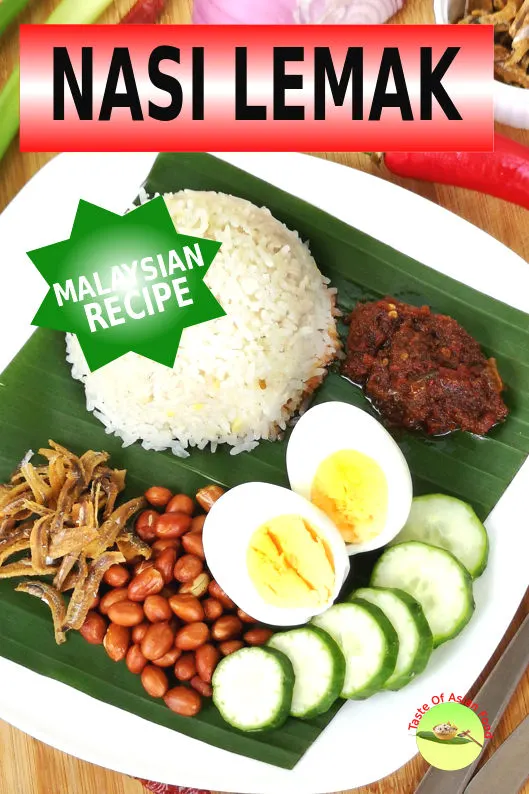
My cousin Angie Branca is the owner of Sate Kampar, a restaurant offering Malaysian food at Passyunk Ave, Philadelphia, Pennsylvania, which offers the real deal Nasi Lemak. She imports most of the spices and unique ingredients directly from Malaysia. PappaRich, a chain restaurant, also spread its wings to Melbourne, Australia, to offer authentic Malaysian delights. Air Asia, the Malaysia-based budget airline, also offers Nasi Lemak Pak Nasser on their menu.
If you are unfortunately not living in these places, and your stomach is growling, read this article. I will cover every trick and technique I have picked to prepare this ultimate comfort food that can satisfy almost every palate.
Note: This post may contain affiliate links. Please read my privacy policy for more info. I may receive commissions for purchases made through links in this post. As an Amazon Associate, I earn from qualifying purchases.
1. What is nasi lemak?
There is no introduction required to the Malaysian and Singaporean about Nasi Lemak. However, people who live outside this region may not be familiar with it.
Nasi Lemak means Creamy Rice in Malay. It is prepared with long grain (or medium grain) rice, coconut milk, ginger, onion, and pandan leaf (screwpine leaf).
The principal ingredients for nasi lemak are rice and thick coconut milk, but using good chicken stock to replace water to heighten the flavor of Nasi Lemak is recommended.
Nasi lemak is served with a variety of side dishes. These are sambal (chili pasteIkankan Bilis (dried anchovies), hard-boiled eggs, fresh slices of cucumber, and groundnuts.
Nasi lemak is commonly served during breakfast. Chicken curry, assam prawns, or fried chicken are added to make up a complete meal for the more lavish version.
2. How to cook nasi lemak (coconut milk rice)
In this article, I am glad to share with you this time-tested Nasi Lemak recipe, which garners massive followers to our café.
Please note that we are revealing our Nasi Lemak Malaysian style recipe, which can be different from others you might have tried. After all, the chef injects his idof interpretingret Nasi Lemak to his expectations.
Are you ready to dig in? Let’s kicks thing off with step one.
A. Cook the rice
Long grain rice is the preferred choice for preparing Nasi Lemak.
The preparation starts with rinsing the rice, just like cooking steamed rice.
How many times should you rinse the rice?
It is an interesting question raised by some of our kitchen staff. My view is if the rice is relatively clean, you only need to rinse it once or twice. If you are concerned about the cleanliness, rinse it with water for a few more rounds. Cleanliness is the primary goal.
The secondary goal is to wash away as much starch as possible to make the rice less sticky. Repeatedly rinsing the rice helpfulful if you prepare fried rice, which you aim to avoid the rice from sticking to the wok.
Since we want to cook Nasi Lemak, which should be creamy ideally, I suggest stopping rinsing the rice once it is clean.
Next, cook the rice in the rice cooker or over the stovetop with all the ingredients in the recipe. There is no complicated step, just straightforward cooking. The success lies in the combination of ingredients. However, you may need to pay attention to the amount of liquid you use to cook the rice.
The quantity of liquid to cook the rice
The total liquid I use is 1.75x the weight of the dry rice.
- Measure the dry weight of the rice.
- Rinse the rice. Remove as much water as possible.
- Add all the ingredients into the rice cooker, except the coconut milk and water.
- Now for every 100g of dry rice, I will add 175ml of liquid to cook the rice. (Long grain rice in this case). The 175ml liquid consists of 1 part of coconut milk, one part of chicken stock, and one part of water. In practice, I put an empty bowl on the digital weighing scale, then added the coconut milk and stock. Lastly, top up the amount to 175ml with water.
- Pour the liquid into the rice cooker, and that is.
Note: I use fresh coconut milk (also called coconut cream). If you use those in a packet, ensure that the fat content is between 20% and 25%.
B. Prepare the sambal (chili paste) for nasi lemak
This nasi lemak sambal is specially developed for nasi lemak. Sambal is the Malay word for chili paste. It is the most crucial component for Nasi Lemak apart from the rice. Below is my method to make the sambal.
Prepare the onion and garlic paste
- Blend the onion and garlic with oil. Some cooks like to add a few slices of galangal and ginger to the onions, which is optional.
- I discourage adding water to blend the aromatics, as it will prolong the time required to caramelize the onion. It is, therefore, better to add cooking oil to the onion instead. The amount of oil in the recipe is only for reference. You need to add the oil into the food processor slowly and stop when the quantity of the oil is enough to carry the onions to spin smoothly.
- Blend the onions until it forms a smooth paste. Then transfer it to a wok or pan. Saute the paste until it caramelizes and turns brown, which will take about ten minutes over low to medium heat.
Dried chili, red chili, and dried shrimps
- Cut the dried chili into small sections and remove as many seeds as possible. If you do not remove the seeds, they will remain in the sambal since the blender cannot crush them. As a result, many seeds will be present in the sambal, which is undesirable.
- Boil the dried chili in water until it turns soft, which may take ten to fifteen minutes. Then remove and drain on a wire mesh strainer. The dried chilies are soft enough to be blended into a smooth paste.
- Next, remove the seeds of the red chilies and then cut them into short pieces.
- Soak the dried shrimps in hot water until it becomes soft.
- Now put the dried chili, red chili, dried shrimp, and some oil to blend into a paste.
Simmer the sambal
- Combine the chili paste with the caramelized onion in a wok or a large saucepan. Simmer for half an hour. The mixture will become thicker. Add some water if it is too dry.
- Add the onion slices. (Slice, not blend.)
- Add the tamarind water, palm sugar, and salt to season the sambal.
- Simmer for up to an hour or until it becomes shiny and the oil separates from the sambal. It is now really to serve.
Additional note:
- Use red onion, which are sweeter than yellow onion.
- Also, our recipe does not include belacan (shrimp paste).
- Use oil instead of water to facilitate blending. Sambal requires plenty of oil to cook right. If there is too much oil after cooking, you can remove the excess oil floating on top of the sambal. This oil is delicious for cooking mee goreng, fried eggs, or used during the next batch of sambal.
- Simmer the sambal for at least an hour to remove as much water as possible. This way, the sambal can be kept at room temperature for three to four days. You can also freeze the sambal if you want to keep it for a few months.
- You can also add some fried anchovies to the spicy sambal to become sambal ikan bilis. However, I do not do that as I am serving with plenty of fried anchovies separately.
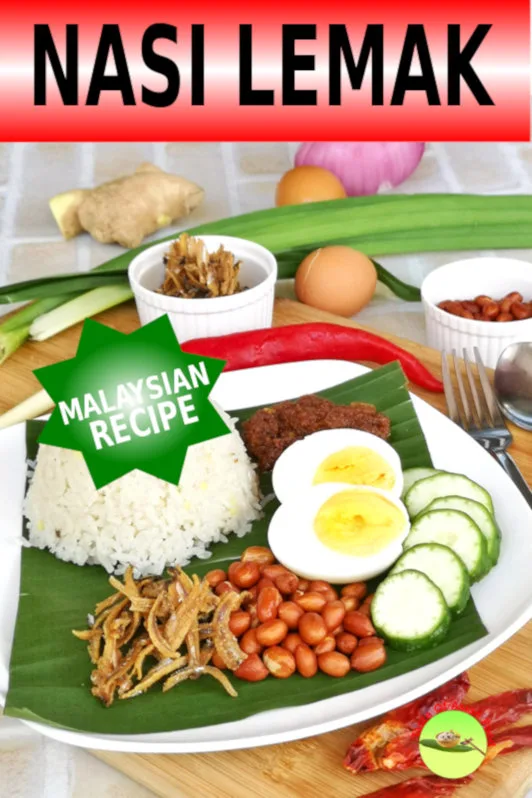
C. Fry the groundnuts
The next item for the Nasi Lemak is fried groundnuts.
You can either lightly fry the groundnuts with minimum oil in a pan or toast the groundnuts in the oven.
Since the fried groundnuts can be stored in an airtight container for a long time, it is more efficient to make a large batch. The extra can be used in other recipes or as a tasty snack.
D. Deep-fry the Ikan Bilis (Anchovies)
The third standard item to serve with Nasi Lemak is fried anchovies (Ikan Bilis).
The preparation is a no-brainer. However, one should not take it too lightly as it has to fry until crispy.
Here are the steps :
- Heat the cooking oil in the wok.
- Deep-fry the anchovies in oil. The oil must be enough to submerge all the anchovies.
- You need to deep-fry the anchovies until crispy. It is ready when the oil stops popping tiny bubbles emerge at the side of the anchovies. It will take at least five minutes.
- Remove the crispy anchovies with a slotted spoon and drain them on paper towels.
- Keep it in an airtight container if you are not serving it immediately.
E. Get ready some hard-boiled eggs
The last common ingredient to serve with Nasi Lemak is a hard-boiled egg.
We have a complete guide on making the perfect hard-boiled egg on this blog; you can refer to the details.
In summary, here is a brief instruction on how to make it :
- First, bring a pot of water to a boil.
- Submerge the eggs in the water entirely, then simmer the eggs at the sub-boiling point by reducing the heat to barely enough to sustain minimal boiling.
- Boil for sixteen minutes for hard-boiled and eight minutes for soft-boiled eggs.
- Transfer the eggs to ice water to prevent further cooking immediately.
- Peel, cut, and serve.
3. Put it all together
- Scoop the rice onto the plate.
- Arrange the crispy anchovies, hard-boiled eggs, cucumber slices, and ground nuts around the rice.
- Place a dollop of sambal on top of the rice.
- Served with chicken curry, fried chicken, beef rendang, or tamarind prawns.
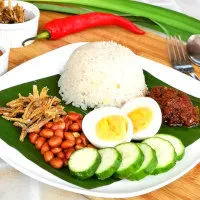
Nasi Lemak
Nasi Lemak 椰漿飯 is the breakfast and lunch staple in Malaysia. This drool-worthy, gluttonous gem is offered in almost every local Malay and Mamak restaurant. Wrapped in paper and banana leaves, this Nasi Lemak Bungkus (wrapped coconut milk rice) has become the quintessential breakfast for the locals.
Ingredients
Nasi Lemak:
- 250g (8.8 oz) Long grain rice
- 150ml (5.3 oz) coconut milk
- 150ml (5.3 oz) chicken stock
- 125ml (half cup) water
- 2 pandan leaves
- 1 lemongrass, bashed
- 1tsp minced ginger
- 1 tbsp chopped onion
- 1/2 tsp (2.5g) sslt
- 1/2 tsp fenugreek
Sambal
- Ingredients A:
- 200g (7oz) of onions
- 50g (1.7 oz) of garlic
- 75m (5 tbsp) cooking oil or sufficient to blend smoothly.
- Ingredients B:
- 150 g (5.3 oz) red chilies
- 25g (1 oz) dried chili
- 30g (4 tbsp) dried shrimps, soaked for 20 minutes
- 75ml (5 tbsp) cooking oil
- Ingredients C:
- 75ml (5 tbsp) cooking oil
- Ingredients D:
- 37g (2.5 tbsp) palm sugar
- 1 tbsp tamarind pulp, soak in 1/4 cup of hot water
- 100g (3.5 oz) onion, sliced
- 50ml (1.7 oz) cooking oil add to the sambal
- 4g (3/4 tsp) salt
Others:
- 30 g groundnuts
- 30 g anchovies
- 1 hard-boiled egg
- Few slices of cucumbers
Instructions
For the rice:
- Rinse the rice. Remove as much water as possible.
- Add all the ingredients into the rice cooker.
- Pour the liquid into the rice cooker and that is.
For the sambal:
- Blend the onions and garlic with sufficient oil.
- Saute the onion paste until it caramelized.
- Remove the seeds from the dried chili, then boiled in water until it turns soft.
- Soak the dried shrimps with water for 20 minutes.
- Add the dried, dried shrimps and red chili to the blender. Blend with sufficient oil.
- Add the chili paste to the caramelized onion. Simmer for half an hour.
- Add tamarind juice, palm sugar, and salt.
- Lastly, add the onions and cook until tender.
Others :
- Stir-fry the groundnuts until the color darkens slightly.
- Deep-fried the anchovies until crispy.
- Cut the half boiled egg into two.
- Cut the tomato and cucumber into slices.
Recommended Products
As an Amazon Associate and member of other affiliate programs, I earn from qualifying purchases.
-
 Tamicon Tamarind Paste
Tamicon Tamarind Paste -
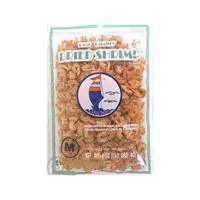 Dried shrimp - 3 oz
Dried shrimp - 3 oz -
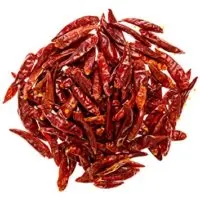 Soeos Szechuan Dried Chili,Dry Szechuan Pepper, Dry Chile Peppers, Sichuan Pepper, Dried Red Chilies, 4oz, (Very Mild Spicy)
Soeos Szechuan Dried Chili,Dry Szechuan Pepper, Dry Chile Peppers, Sichuan Pepper, Dried Red Chilies, 4oz, (Very Mild Spicy) -
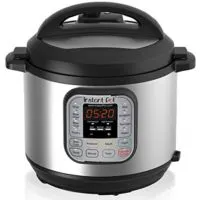 Instant Pot DUO60 6 Qt 7-in-1 Multi-Use Programmable Pressure Cooker, Slow Cooker, Rice Cooker, Steamer, Sauté, Yogurt Maker and Warmer
Instant Pot DUO60 6 Qt 7-in-1 Multi-Use Programmable Pressure Cooker, Slow Cooker, Rice Cooker, Steamer, Sauté, Yogurt Maker and Warmer -
 Joyce Chen 21-9972, Classic Series Carbon Steel Wok Set, 4-Piece, 14-Inch Charcoal
Joyce Chen 21-9972, Classic Series Carbon Steel Wok Set, 4-Piece, 14-Inch Charcoal
Nutrition Information:
Yield: 3 Serving Size: 3 servingsAmount Per Serving: Calories: 1536Total Fat: 41gSaturated Fat: 8gTrans Fat: 0gUnsaturated Fat: 27gCholesterol: 184mgSodium: 1715mgCarbohydrates: 259gFiber: 36gSugar: 122gProtein: 77g
This data was provided and calculated by Nutritionix on 11/1/2019

Ayam goreng - How to make authentic Malaysian fried chicken
Friday 1st of November 2024
[…] Nasi Lemak is the breakfast staple in Malaysia. This drool-worthy, gluttonous gem is offered in almost every local Malay and Mamak restaurant. It’s rice cooked with coconut milk and spices. […]
Ground beef rice 窝蛋牛肉饭- How to prepare a mouth-watering easy meal
Wednesday 9th of October 2024
[…] Nasi lemak – The rice is cooked with coconut milk and served with fried anchovies, roasted groundnuts, and sambal. […]
Malaysian Curry Chicken (kari ayam) - Best curry recipe
Thursday 25th of July 2024
[…] Nasi Lemak is a typical Malaysian dish. You can find this coconut cream flavored rice in any Malaysian store down the street, whether for breakfast, lunch, or dinner. […]
Raj
Monday 14th of February 2022
I just made the rice and it turned out great! thanks for the precise measurements. I used a scale and after washing the rice - waited at least an hour for most of the moisture to drain away to not throw out the water/rice ratio. Will try the sambal next time...
Raj
Saturday 12th of February 2022
Hi - is the chicken stock salted or unsalted?
KP Kwan
Saturday 12th of February 2022
I use the unsalted stock for this recipe.